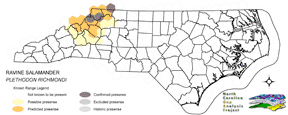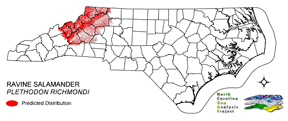
| Taxa: |
| Order: |
| Family: |
| Amphibia |
| Caudata |
| Plethodontidae |
| NatureServe Global Rank: |
| NatureServe State (NC) Rank: |
| G5 |
| S3 |
| Federal Status: |
| NC State Status: |
| --- |
| W2 |


| Land Unit |
| US Fish & Wildlife Service |
| US Forest Service |
| US National Park Service |
| US Department of Defense |
| NC State Parks |
| NC University System |
| NC Wildlife Res. Com. |
| NC Forest Service |
| NC Div. of Coastal Mgmt. |
| Local Governments |
| Non-Governmental Org. |
| Other Public Lands |
| Private Lands |
| GAP Status 1-2 |
| All Protected Lands |
| Statewide |
| Hectares |
| 0.00 |
| 80,086.77 |
| 161.10 |
| 9,611.73 |
| 6,832.98 |
| 83.25 |
| 5,726.97 |
| 584.46 |
| 0.00 |
| 4,795.11 |
| 4,169.34 |
| 40.59 |
| 520,419.06 |
| 31,894.74 |
| 111,984.57 |
| 632,511.36 |
| Acres |
| 0.00 |
| 197,898.68 |
| 398.09 |
| 23,751.10 |
| 16,884.66 |
| 205.72 |
| 14,151.65 |
| 1,444.23 |
| 0.00 |
| 11,848.97 |
| 10,302.66 |
| 100.30 |
| 1,285,983.25 |
| 78,813.60 |
| 276,719.84 |
| 1,562,969.30 |
| % of Dist. on |
| Prot. Lands |
| 0.0 % |
| 71.5 % |
| 0.1 % |
| 8.6 % |
| 6.1 % |
| < 0.1 % |
| 5.1 % |
| 0.5 % |
| 0.0 % |
| 3.7 % |
| 3.7 % |
| 0.0 % |
| 0.0 % |
| 28.5 % |
| ----- |
| ----- |
| % of Dist. on |
| All Lands |
| 0.0 % |
| 12.7 % |
| < 0.1 % |
| 1.5 % |
| 1.1 % |
| < 0.1 % |
| 0.9 % |
| < 0.1 % |
| 0.0 % |
| 0.8 % |
| 0.7 % |
| < 0.1 % |
| 82.3 % |
| 5.0 % |
| ----- |
| ----- |
|
In North Carolina, found in only a couple of northwestern mountain counties next to Virginia (Wilson 1995). Strongly associated with rocky habitats, this species lives in ravines typically covered in deciduous forest (Petranka 1998). It can be locally abundant in and around talus slopes and shaded outcrops. Wooded slopes with friable soil and large flat rocks are good habitat as well. Rarely found in floodplains or on dry ridgelines (Petranka 1998). Shows a preference for rock cover as shelter (Petranka 1998). NATURE SERVE GLOBAL HABITAT COMMENTS: Found under logs, rocks, or leaf litter in wooded areas. Moves underground in mid-winter and during summer dry spells; deep underground early June-late September in West Virginia (Green and Pauley 1987). Lays eggs under rocks or in underground cavity. |
| Code | Name | Description | NC Natural Heritage Program Equivalent |
| 230 | Piedmont Mesic Forest | American Beech - Red Oak - White Oak Forests. | Mesic Mixed Hardwood |
| 383 | Piedmont Mixed Successional Forest | Generally loblolly mixed with successional hardwoods. Sweetgum, tulip poplar and red maple are common co-dominants in these successional forests. | No equivalent |
| 228 | Piedmont Dry-Mesic Oak and Hardwood Forests | Primarily oak dominated forests, white oak is often dominant, with co-dominants including . Also represented by sweetgum and tulip poplar dominated forests. | Dry Mesic Oak Hickory Forest, Basic Oak Hickory Forest, Dry Oak Hickory Forest |
| 522 | Northern Hardwoods | High Elevation forests including yellow birch, American beech, and yellow buckeye. Includes forests with Hemlock and Yellow Birch. | Northern Hardwoods Forest, Boulderfield Forest |
| 525 | Appalachian Oak Forest | A variety of oak forest types including Black, White, Scarlet Oaks in dry to mesic situations. Includes forests historically co-dominated by American Chestnut. | High Elevation Red Oak Forest, Montane White Oak Forest |
| 526 | Appalachian Cove Forest | Mixed Mesophytic forests of the mountains. Includes tuliptree, basswood, yellow buckeye and surgar maple. This class is mapped to include cove forests dominated or co-dominated by hemlock. | Rich Cove Forest, Acidic Cove Forest |
| 527 | Appalachian Hemlock | Upland hemlock forests of the moutains region. Vary from side slopes to steep slope positions. | Canada Hemlock Forest |
| 530 | Appalachian Xeric Deciduous Forest | Deciduous forests in the mountains dominated by Xeric Oak species. Species include, white, Southern red, black, and rock chestnut. | High Elevation Red Oak Forest, Montane White Oak Forest |
| 535 | Talus/Outcrops/Cliffs | Includes seep talus slopes with sparce vegetation, as well as outcrops including, granitic outcrops. Some outcrops will have been mapped as barren rock. | No equivalent |
|
Wilson, L. A. 1995. The Land Manager's Guide to the amphibians and reptiles of the South. Chapel Hill, NC: The Nature Conservancy.
Petranka, J. W. 1998. Salamanders of the United States and Canada. Washington DC: Smithsonian Inst. Press. Barbour, R. W. 1971. Amphibians and reptiles of Kentucky. Univ. Press of Kentucky, Lexington. x + 334 pp. Minton, S. A., Jr. 1972. Amphibians and reptiles of Indiana. Indiana Academy Science Monographs 3. v + 346 pp. Behler, J. L., and F. W. King. 1979. The Audubon Society field guide to North American reptiles and amphibians. Alfred A. Knopf, New York. 719 pp. Green, N. B., and T. K. Pauley. 1987. Amphibians and reptiles in West Virginia. University of Pittsburg Press, Pittsburg, Pennsylvania. xi + 241 pp. |
For more information please contact them at:
NC-GAP Analysis Project
Dept. of Zoology, NCSU
Campus Box 7617
Raleigh, NC 27695-7617
(919) 513-2853
www.basic.ncsu.edu/ncgap